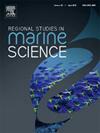Ecological impact of artificial barrage on calanoid copepods in the Vembanad Lake, Southwest Coast of India
IF 2.1
4区 环境科学与生态学
Q3 ECOLOGY
引用次数: 0
Abstract
The Vembanad Lake (VL) is a brackish water lagoon, an integral part of Ramsar site, Vembanad Kol Wetland ecosystem on the southwestern coast of India. VL faces escalating anthropogenic impact, notably worsened by the establishment of the Thanneermukkom barrage (TMB) in 1976. This study hypothesizes that the TMB has led to significant ecological changes in VL, specifically altering the distribution and abundance of calanoid copepods, which are vital as a food source for higher trophic levels, particularly fish. To test this hypothesis, zooplankton samples were collected from various sites along the lake, and environmental parameters such as salinity and chlorophyll-a concentration were measured. This investigation reveals a distinct limnetic zone in the southern region, in contrast to the oligo-mesohaline zone in the north, attributed to the TMB. The study identifies the prevalence of calanoid copepod species such as Heliodiaptomus cinctus, Allodiaptomus mirabilipes, and Acartiella gravelyi in the TMB-South region, reflecting a freshwater-dominated ecosystem. The low salinity and high chlorophyll-a content in this area create an optimal environment for these species. In contrast, the dominance of Acartia (Odontacartia) spinicauda, Pseudodiaptomus serricadatus, and Paracalanus sp. in the TMB-North indicates higher salinity levels, with species in this region adapting to a different ecological niche. Thus, the installation of the TMB has significantly altered the ecological balance of VL by dividing the water body into two distinct salinity zones. This separation has led to changes in the distribution and abundance of calanoid copepods, which are essential for energy transfer to higher trophic levels in the VL food web, consequently affecting fish populations and overall biodiversity.
人工拦河坝对印度西南海岸 Vembanad 湖中桡足类的生态影响
文巴纳德湖(VL)是一个咸水泻湖,是拉姆萨尔湿地文巴纳德科尔湿地生态系统的组成部分,位于印度西南海岸。VL 面临着日益严重的人为影响,1976 年修建的 Thanneermukkom 拦河坝(TMB)更是加剧了这一影响。本研究推测,TMB 已导致 VL 生态发生重大变化,特别是改变了桡足类的分布和数量,而桡足类是较高营养级(尤其是鱼类)的重要食物来源。为了验证这一假设,我们从湖泊沿岸的不同地点采集了浮游动物样本,并测量了盐度和叶绿素-a 浓度等环境参数。这项调查显示,南部地区有一个独特的底栖生物区,与北部的寡淡水区形成鲜明对比,这归因于 TMB。研究发现,在港珠澳大桥南段区域,桡足类(如 Heliodiaptomus cinctus、Allodiaptomus mirabilipes 和 Acartiella gravelyi)物种十分普遍,这反映了以淡水为主的生态系统。该地区的低盐度和高叶绿素-a 含量为这些物种创造了最佳环境。与此相反,TMB-北区的刺尾鲃(Odontacartia)、伪二鳃鲃(Pseudodiaptomus serricadatus)和副鳃鲃(Paracalanus sp.)占优势,表明盐度较高,该区域的物种适应了不同的生态位。因此,港珠澳大橋的設置,把大嶼山水域分為兩個不同的鹹度區,大大改變了大嶼山的生態平衡。这种分隔导致桡足类的分布和数量发生变化,而桡足类是向 VL 食物网中较高营养级传递能量的关键,因此影响了鱼类种群和整体生物多样性。
本文章由计算机程序翻译,如有差异,请以英文原文为准。
求助全文
约1分钟内获得全文
求助全文
来源期刊

Regional Studies in Marine Science
Agricultural and Biological Sciences-Ecology, Evolution, Behavior and Systematics
CiteScore
3.90
自引率
4.80%
发文量
336
审稿时长
69 days
期刊介绍:
REGIONAL STUDIES IN MARINE SCIENCE will publish scientifically sound papers on regional aspects of maritime and marine resources in estuaries, coastal zones, continental shelf, the seas and oceans.
 求助内容:
求助内容: 应助结果提醒方式:
应助结果提醒方式:


